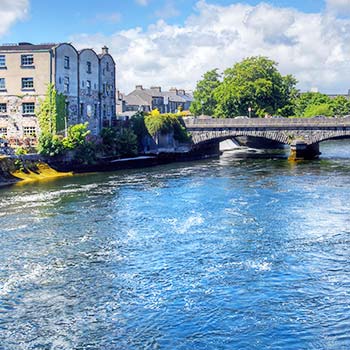Coastal and Offshore Engineering
University of Galway - Engineering & Computer Science Program
Galway, Ireland
Dates: 1/3/23 - 5/6/23

Coastal and Offshore Engineering
OVERVIEW
CEA CAPA Partner Institution: University of Galway
Location: Galway, Ireland
Primary Subject Area: Civil Engineering
Instruction in: English
Course Code: CE462
Transcript Source: Partner Institution
Course Details: Level 400
Recommended Semester Credits: 2.5
Contact Hours: 36
DESCRIPTION
Learning Outcomes
1. Solve the nonlinear dispersion equation for wavelength using either tables or Excel; calculate water particle velocities and accelerations (needed later for evaluating forces on piles and frames).
2. Calculate the dynamic pressure due to the waves in order to calculate indirectly the wave height. Derive the equation H=KR KSH0 describing shoaling and refraction; calculate the wave height in shallow water for various deep-water incident heights and angles (shoaling, refraction, and breaking).
3. Plan a port facility taking into account the following: determining the best location of the harbour; land requirements for port development; size and shape of harbour and turning basin; type, location, and height of breakwaters; location and width of entrance to the harbour; and depth of harbour and approach channel. Recognize and describe shipping terminals handling general cargo, bulk cargo, and containers; evaluate the wave forces on a seawall due to breaking- or non-breaking waves; design a breakwater.
4. Describe and illustrate the longshore and rip currents and setup/setdown in the coastal zone caused by breaking waves; use the sediment budget in a coastal cell to decide whether erosion or accretion of shoreline is probable; use correlations involving hinterland area and effective precipitation to evaluate the amount of sediment carried by a river into the cell; calculate the longshore transport of sediment from incident wave conditions; Design a coastal defence scheme using beach nourishment; compare native sand with borrowed sand to determine overfill and frequency of renourishment; design a groyne field for protecting beaches.
5. Derive tidal equations for estuaries with and without friction; calculate tidal ranges and velocities at different points along the estuary; Derive Darwin?s equilibrium model of global tides taking the lunar and solar contributions into account; calculate and plot the tidal variation over a 24-hour period for various declinations of the moon and for various latitudes, showing diurnal, semidiurnal, and mixed tides; explain the harmonic analysis of the tides; explain a tide predicting machine.
6. Describe the three-dimensional motion of floating bodies (surging, swaying, heaving, rolling, pitching, and yawing) such as barges, cylinders, ships, and tension leg platforms; explain and use the six equilibrium equations for a floating body.
7. Display the shape of a mooring line connecting a floating body to an anchor; design a complete mooring system, including the environmental forces on the floating body, the link size of the mooring chain, the weight per unit length of mooring chain, the required length of mooring chain subject to various constraints; specify constraints such as the angle between the seabed and the mooring chain at the anchor, the maximum distance in plan between the anchor and the floating body. Design the fendering system and berthing dolphins for a berthing ship. Explain, formulate and calculate nonlinear dynamics of moored floating bodies using perturbation.
8. Explain, formulate and calculate the in-line force on the cross-section of a structural member through the use of Morison?s equation together with Cd and Cm values appropriate to that section, and the transverse force through the use of the appropriate lift coefficient.
9. Predict the significant wave height and period for given wind conditions such as fetch, duration, wind speed, and decay distance; formulate the wave spectrum corresponding to particular wind conditions; calculate the temporal wave series corresponding to a particular spectrum; waves as a random process.
10. Describe and illustrate the nine or so basic wave energy conversion techniques; define the basic and advanced electromechanical energy conversion techniques.
11. Explain the United Nations Law of the Sea and apply it to Ireland?s continental shelf. Explain, formulate and do calculations on the earth?s model as set down in the Law of th
1. Solve the nonlinear dispersion equation for wavelength using either tables or Excel; calculate water particle velocities and accelerations (needed later for evaluating forces on piles and frames).
2. Calculate the dynamic pressure due to the waves in order to calculate indirectly the wave height. Derive the equation H=KR KSH0 describing shoaling and refraction; calculate the wave height in shallow water for various deep-water incident heights and angles (shoaling, refraction, and breaking).
3. Plan a port facility taking into account the following: determining the best location of the harbour; land requirements for port development; size and shape of harbour and turning basin; type, location, and height of breakwaters; location and width of entrance to the harbour; and depth of harbour and approach channel. Recognize and describe shipping terminals handling general cargo, bulk cargo, and containers; evaluate the wave forces on a seawall due to breaking- or non-breaking waves; design a breakwater.
4. Describe and illustrate the longshore and rip currents and setup/setdown in the coastal zone caused by breaking waves; use the sediment budget in a coastal cell to decide whether erosion or accretion of shoreline is probable; use correlations involving hinterland area and effective precipitation to evaluate the amount of sediment carried by a river into the cell; calculate the longshore transport of sediment from incident wave conditions; Design a coastal defence scheme using beach nourishment; compare native sand with borrowed sand to determine overfill and frequency of renourishment; design a groyne field for protecting beaches.
5. Derive tidal equations for estuaries with and without friction; calculate tidal ranges and velocities at different points along the estuary; Derive Darwin?s equilibrium model of global tides taking the lunar and solar contributions into account; calculate and plot the tidal variation over a 24-hour period for various declinations of the moon and for various latitudes, showing diurnal, semidiurnal, and mixed tides; explain the harmonic analysis of the tides; explain a tide predicting machine.
6. Describe the three-dimensional motion of floating bodies (surging, swaying, heaving, rolling, pitching, and yawing) such as barges, cylinders, ships, and tension leg platforms; explain and use the six equilibrium equations for a floating body.
7. Display the shape of a mooring line connecting a floating body to an anchor; design a complete mooring system, including the environmental forces on the floating body, the link size of the mooring chain, the weight per unit length of mooring chain, the required length of mooring chain subject to various constraints; specify constraints such as the angle between the seabed and the mooring chain at the anchor, the maximum distance in plan between the anchor and the floating body. Design the fendering system and berthing dolphins for a berthing ship. Explain, formulate and calculate nonlinear dynamics of moored floating bodies using perturbation.
8. Explain, formulate and calculate the in-line force on the cross-section of a structural member through the use of Morison?s equation together with Cd and Cm values appropriate to that section, and the transverse force through the use of the appropriate lift coefficient.
9. Predict the significant wave height and period for given wind conditions such as fetch, duration, wind speed, and decay distance; formulate the wave spectrum corresponding to particular wind conditions; calculate the temporal wave series corresponding to a particular spectrum; waves as a random process.
10. Describe and illustrate the nine or so basic wave energy conversion techniques; define the basic and advanced electromechanical energy conversion techniques.
11. Explain the United Nations Law of the Sea and apply it to Ireland?s continental shelf. Explain, formulate and do calculations on the earth?s model as set down in the Law of th










